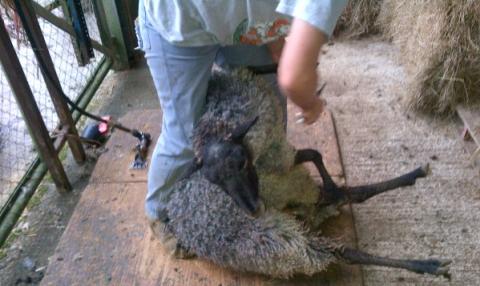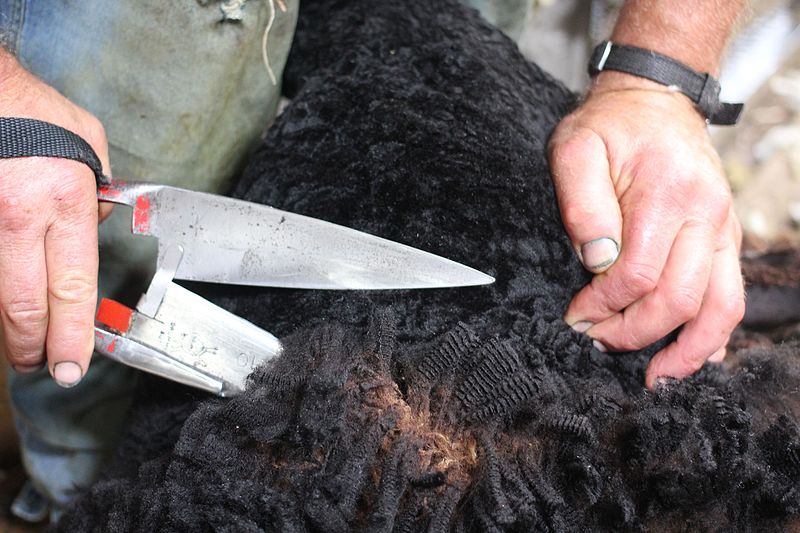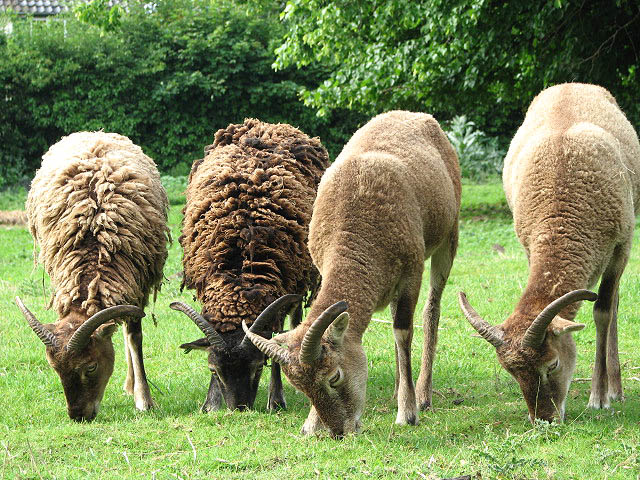We are always honoured and delighted to include articles from honorary Team Wovember member, Sue Blacker. This year we asked if we may re-publish a recent blog post that Sue wrote at her own blog, part of a series there on the journey that wool takes from sheep to skein.
You may have seen the recent resurfacing of PETA’s campaign against wool and particularly on shearing. Our theme is where wool meets wellness and this post concerns the wellbeing of our wool providers.

Pure new wool comes from live sheep and sheep are not killed in the shearing process! This blog item focuses on how to shear live sheep with care and respect.
Nowadays sheep are shorn, mostly once a year, generally by using electrical shearing machines. The shearing machines have a fixed comb which travels across the skin, lifting the fleece, and then a cutter above the comb will cut across the raised fleece – the same design as for human electrical clippers and razors and for hedge clippers. Before electrical power, whether fixed or using a vehicle battery or generator as the power source, the power was provided by a person turning a wheel to drive the clippers – pretty hard work despite the apparently relaxed posture shown in the photo below – and then by a petrol engine. It is interesting that the British car makers Wolseley and Austin first set up as manufacturers of shearing equipment, diversifying into automobiles to address seasonality.

However, where there is no power, hand shearing, using blades which have been unchanged in design for centuries, is still important. In addition, where sheep are shown on highlands, the hand shearing technique generally leaves more wool on the animal, enabling it to withstand cold nights better. Blade shearing is also quieter, so the sheep seem to prefer it, although hand shearing takes roughly twice as long as powered shearing.

Whether using hand blades or a machine, most shearers use the Bowen technique, developed by New Zealanders Godfrey and Ivan Bowen in the 1940s to remove the fleece efficiently in a single piece and with the minimum amount of movement and stress to the animal. There is a small piece of film of Godfrey shearing to be seen by clicking this external link. There is also a longer version showing exactly how the technique works on a shorn sheep as well as then on actual shearing though the film also shows less respect for the sheep than would be expected nowadays at this link . Godfrey managed not only a shearing world record in 1953, but also achieved both a British MBE and a Russian Star of Lenin and Hero of Labour for his services to farming.
Some sheep, such as Shetland, Soay and Boreray, will shed their fleeces if not shorn and this can be accelerated by the technique of rooing, which involves using the hands as combs to push through the fleece from the front and in effect combing out the shed fleece, leaving the new growth for the next year. Some Manx sheep will do this too.

There are films which show rooing, which shows how it works. It takes a little longer and if the sheep has been left until the fleece is really loose, it also comes off in loose pieces rather than as a whole fleece.
However sheep are shorn it is a close-up and physical encounter between a human and the animal and there are of course potential problems, which range from the human getting hurt to the sheep getting hurt in the process. It is, however, an important welfare treatment for the sheep as otherwise the longer and dirty fleece can harbour diseases, attract blowflies and generally hamper the sheep from getting around in good health.
In the UK, sheep shearing training is provided by the British Wool Marketing Board and there are similar courses in South Africa, Australia and New Zealand. A young fit person can travel around the world and find work shearing and teams of shearers from South Africa, New Zealand and Australia work in the UK in our summer, while UK shearers go in the opposite direction in the UK winter, stopping off in the Falkland Islands or Argentina on the way.
Adult sheep can weigh around the same as a person, some more and some less, so shearing is not about brute force, but technique and the calmness of the shearer in reassuring the animal. The Bowen technique does not actually hold the animal, using one hand to hold the shearing blades and the other to move the sheep around and stretch the skin ahead of the blades, while the animal is leaned against the legs and moved around by the way the shearer moves his or her legs and feet.
Apart from the obvious care and respect we should show as humans to sheep, there are good commercial reasons for not harming sheep when shearing:
- They are valuable animals and sickness or damage reduces their value.
- Sheep have excellent memories and will behave badly when next shorn if they suffered the last time.
- Repairing the damage takes time, which is at a premium when shearing large flocks.
- Damage to the sheep can mean damage to the fleece and less value for the wool.
- Although domesticated, sheep are essentially still wild animals and most of them are not household pets, so they need this respect.
Ensuring the minimum damage to all involved requires the following good practices:
- Employing an experienced and properly trained shearer, on recommendation from other customers;
- If employing a novice, ensuring that there is supervision by a trained shearer or shearing trainer;
- Preparing the shearing area properly so that it is clean and tidy, with adequate space for the sheep waiting to be shorn and an easy exit to food and water for the shorn sheep; also adequate space to collect and pack the fleeces and a sheep first aid kit including anti-biotic spray for minor cuts and suturing for worse ones;
- Apart from the shearer there must be sufficient people to manage the sheep into and out of the shearing area and to pick up the fleeces, sort and pack them and clean up between each shearing;
- Preparing the sheep properly – they need to be healthy;
- Shearing wet sheep is dangerous for both the sheep and the shearer and should never be done.
- Sheep have complex digestive arrangements, needed to turn grass into nourishment, and if their stomachs are full of grass or even just water from drinking they are less able to tolerate being turned upside down and rotated to remove their fleeces, so they should be fasted for 12 hours overnight and in a dry barn before shearing. If this is not possible they should be kept in a small enclosure with little grass. Like us they do not die of starvation, nor does their milk dry up, in a twelve hour period;
- Weak, thin or unwell sheep and under-sized lambs should not be shorn – better to lose a fleece than a sheep!
- Larger, heavier animals may need two people to shear them, as does rooing, as this is done standing;
- Sheep should be organised in their normal family groups for shearing – this is not the time to wean lambs or put all the rams and ewes together! Shearing is stressful and this should be minimised.
- Sheep should not be shorn the day after a long journey or within five weeks of lambing, although trimming around the tail can be helpful for lambing ease and for the lambs to find the milk;
- Sheep which are particularly large, or have back or other problems which would mean they should not be turned over may be shorn standing, generally leaving the legs and belly unshorn;
- Sheep should not have been treated recently with anti-blowfly pesticides as this contaminates the wool and is not good for the shearer either – he or she will be getting multiple doses from each sheep shorn rather than the relevant dose for the sheep. We would advocate not using these chemicals unless unavoidable;
- As the sheep are already in and under control, this is also the time to check them carefully, trim and treat any feet which need it and replace lost ear tags, instead of subjecting them to a separate stressful event.
- Sheep are normally shorn on a wooden shearing board or floor, so that they will slide around easily – not on the ground! Also the board can be swept between each animal to avoid colours and qualities being mixed. Hence sweeping the board, with a clean sweep, has passed into the language for a proper clean result!
Footnote about wool from dead sheep
There is a type of wool, known as slipe wool, which is taken from the skins of sheep slaughtered for meat when they are being made into leather rather than sheepskins using a process called fell-mongering, which uses sodium sulphide to dissolve the fibre roots in washed sheepskins so that it can be removed. However, this is not done in the UK so wool labelled as British Wool will only have been shorn from live sheep with high welfare standards – it is very difficult to know whether and to what degree slipe wool is included in wool from other countries, but it is only around 5% of total world wool production. It appears likely that the origin of the word slipe may be from slipping, as if a sheepskin becomes warm instead of being cooled, washed and salted after it is removed from the sheep, the wool will fall or slip off as the roots of the hairs are closest to the skin which will begin to biodegrade with warmth.
This post appeared first as a blog at blackeryarns.co.uk and we thank Sue for allowing us to re-print it here. Please visit that blog for more images and to read the rest of the Wool Journey series.
If you are interested in further reading on shearing, we found this great post at Vogue, on female shearers in America. It features amazing images too.
> Women of Wool, by Rebecca Bengal
and thanks to Jane Cooper who brought a post to our attention from Craftsmanship Quarterly, concerning some of the hidden facts behind eco-fashion and so-called vegan materials, which can be damaging to the enviroment.